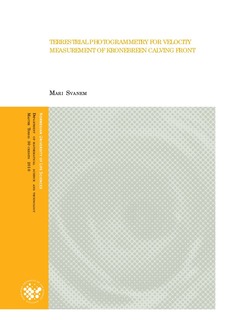| dc.description.abstract | Satellittbilete har lenge vore bruka til å måle hastigheit på isbrear. Den tidsmessige nøyaktigheita for denne metoden er begrensa til banemønsteret, medan den romlege oppløysinga blir bestemt av
opptaksgeometrien. Terrestrisk fotogrammetri gir meir detaljert informasjon både i tid og stad, men gir i
staden andre utfordringar. Hastigheita er måla så nær kalvingsfronten på Kronebreen som praktisk mogleg. Det er satt ut to kamera for å fotografere brefronten: Eit står sør for Kronebreen og tek bilete
kvar time, medan det andre fotograferer kvar sjette time frå nordsida av breen. Hastigheitsmålingane er utført i bilete frå juni til august 2007, mai til oktober 2009 og april til august 2010. Posisjonsforskjellen mellom to matcha biletepar viser forflytning av breen i biletekoordinatar.
Transformasjon til terrengkoordinatar blir gjort ved hjelp av ein høgdemodell og kjende kameraparametre. Hovudvekta av arbeidet viser seg å vere i forarbeidet, sidan bileta har ulik referanseramme på grunn av kamerabevegelse i løpet av opptaksperioden. Den attverande forskjellen etter eventuell transformasjon til same referanseramme utgjer den største
andelen av usikkerheit i resultata. Ingen kamarakalibrering, ikkje tilfredsstillande transformasjon, biletekvalitet, matching av bileta, georeferering, høgdemodell og bileteoppløysing gir ei total nøyaktigheit på 1,5 piksel i bilete teke frå kamera 1. På eit punkt 2500 m unna, utgjer dette 0,84 m feil i eit matcha biletepar. Dette gir ei nøyaktigheit på 0,32 m/dag dersom det er 4 dagar mellom bileta. Ved å måle hastigheita frå bilete med 2, 4 og 8 dagar mellom, gir fire dagar det beste resultatet. Færre dagar mellom bileta gir dårlegare nøyaktigheit for dagleg hastigheit, men betre tidsmessig oppløysing. Resultata er presentert som grafar med variasjon i hastigheit over tid. Desse er samanlikna med temperatur og nedbør i same tidsrom. Romleg variasjon er presentert som hastigheit på tvers og langs bevegelsesretninga på breen. Samanlikning med med tidlegare tverrprofilar i same område, GPS-målingar frå same tid, men lengre opp på breen, og hastigheit frå satellittbilete med dårlegare romleg oppløysing, viser samsvar med våre målingar frå terrestrisk fotogrammetri. Crevasse tracking in optical satellite images has successfully been used for mapping glacier velocities. Temporal resolution is restricted to the repeat orbit periods, and the spatial resolution according to
recording geometry. Terrestrial photogrammetry offers an advantage in both temporal and spatial resolution, but introduces other challenges. We have applied terrestrial photogrammetry close to the calving front of Kronebreen, in order to map velocities close to the terminus.
Two cameras are placed near the front, one south and one north of the measured points on Kronebreen, recording photographs every hour and every sixth hour. This project aims to analyze images from June to August 2007, May to October 2009 and April to August 2010. The velocity is found as displacement between matched image pairs. Displacement is then transformed
into terrain coordinates by means of an elevation model and camera parameters. The preprocessing proved to be the main part of the work, as the images have different reference frame because of
camera motion within the periods.
This transformation of images into the same reference frame includes the largest percentage of uncertainty of the results. Non satisfactory transformation, image quality, image matching and
georeferencing process, elevation model and spatial resolution of the images make a total accuracy of 1.5 pixels in images taken from camera 1. The uncertainness is 0.84 m for a point 2500 m from the
camera for every match. The absolute accuracy of the daily velocity belongs together with the numbers of days between the matched image pair, and will be 0.32 m with 4 days between the images.
By measuring velocity from images with 2, 4 and 8 days between, a temporal resolution of four days gives the best results. Choice of fewer days gives worse accuracy for daily velocity, but better temporal resolution. The results are presented as velocity graphs showing temporal variations together with temperature and precipitation. Spatial variations are displayed in graphs as velocity across and along the glacier
tongue. Comparisons with with earlier cross profiles from the same area, GPS measurement from the same time on
the same glacier and velocity from satellite images with worse spatial and temporal resolution, support the results from terrestrial photogrammetry. | en_US |
